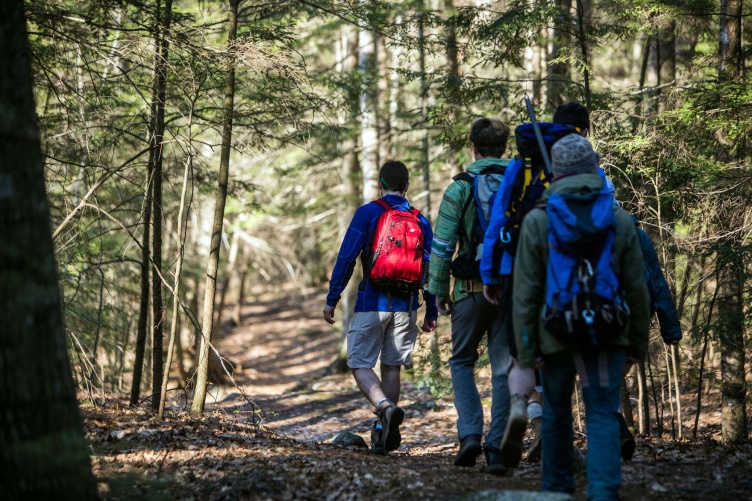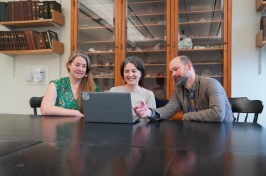
Members of a UNH student organization walk through College Woods. Comprising 250 acres of woods, streams and small fields, College Woods is the oldest and most intensively used University property, and it's not uncommon to see walkers, runners and classes all in one brief stroll through the woods.
Research Goals:
Examine the relationship between wildlife biodiversity, forest management, perceptions of biodiversity, and psychological wellbeing in recreational hiking, with the aim of investigating how higher biodiversity and accurate perceptions of biodiversity contribute to increased health benefits.
The popularity of hiking in the United States continues to surge, and that’s good for New Hampshire’s recreational tourism landscape. The White Mountain National Forest, which spans 800,000 acres in northern New Hampshire and a section of eastern Maine, welcomes more than six million visitors per year to its 1,200-plus miles of hiking trails (including 160 miles of the Appalachian Trail), and the White Mountains includes just a small portion of the Granite State’s many scenic hiking trails. And while lots of research points to the health benefits—both physical and mental—of hiking, less is known about how the biologically diversity of the surrounding forest can add to those benefits.
New research at the New Hampshire Agricultural Experiment Station (NHAES) seeks to better understand how our mood and mental wellbeing changes in biologically diverse environments and whether hiking on trails with greater and more diverse animal and plant life improves psychological health benefits. The study—supported by the new NHAES Collaborative Research Enhancement and Team Exploration (CREATE) program—is being led by an interdisciplinary team of UNH researchers from the College of Life Sciences and Agriculture (COLSA) and the College of Health and Human Services (CHHS).
UNH’s College Woods, one of the study areas for new research into the connection between wildlife biodiversity and psychological wellbeing, is a popular recreational area located in Durham. Visit the College Woods Healthy UNH website.
New Hampshire: A Nature-based Tourism Economy
“Outdoor recreation activities that take place in New Hampshire’s forests are integral to our nature-based tourism economy,” described Lauren Ferguson, an assistant professor of recreation management and policy at CHHS. “Outdoor recreation visitors are often seeking opportunities to restore and improve their health and wellness, and empirical evidence that connects healthy ecosystems to improved health outcomes for visitors can be essential for sustaining conservation, community health, and the outdoor recreation economy.”
Does Greater Biodiversity Enhance Outdoor Recreational Experiences?
While previous research indicates that greater biodiversity helps to enhance recreational experiences, this study—led by Ferguson and Remington Moll, NHAES scientist and an assistant professor in the natural resources and the environment department at UNH—takes a multifaceted approach to determining whether people will enjoy hiking more when they know more about the surrounding area’s wildlife and vegetation.
“There’s a large body of evidence that shows humans have improved physical and mental health outcomes when they are exposed to natural environments,” said Ferguson. “But what about a natural environment is good for our health and wellbeing?”
“Perhaps it’s the biodiversity,” she added. “The more species we see and hear could influence our experience and the ecosystem services we receive from spending time in natural spaces.”

Students in the recreation management and policy program at CHHS conducting mock surveys in College Woods. From left, students Faith Bonnett, Katharine Hamel and Andrew Pincince.
Ferguson and Moll, along with Laura Kloepper, an assistant professor of biological sciences at COLSA, and Karina Sanchez, a postdoctoral research associate in COLSA’s natural resources and the environment department, will conduct a field experiment this summer across UNH woodland properties, including Foss Farm, College Woods, Kingman Research Farm and other areas. The researchers will measure the biodiversity of birds, mammals and frogs living in these popular recreational destinations and surveying visitors to determine their perceptions of wildlife biodiversity and psychological wellbeing as it relates to hiking and walking. The study period will span each season, allowing the researchers to assess human perception of biodiversity on a seasonal basis.
“In the spring and summer, you can hear birdsongs, see different animals or plants and trees,” said Ferguson. “In the winter, animals are quiet and there’s less greenery, so we’re curious whether that change influences visitors’ perceptions of biodiversity and their psychological wellbeing.”
According to Moll, one goal of the research is to help “identify management practices that can provide mutual benefits for biodiversity conservation and human health.”
“We manage our forests for multiple users, including wildlife and humans,” said Moll, “and we think there are some hidden connections between these user groups.”
“We manage our forests for multiple users, including wildlife and humans… By quantifying such connections, perhaps we can manage forests more holistically so that increased biodiversity is more explicitly linked to improved human recreational experiences.”
“By quantifying such connections, perhaps we can manage forests more holistically so that increased biodiversity is more explicitly linked to improved human recreational experiences,” he added. “It would be a win-win if we can uncover and boost such connections through coordinated management and outreach.”
That’s where forest management practices related to recreational education potentially come into play. Outreach and educational approaches such as signs, kiosks and nature interpretation programming can improve understanding of forest biodiversity and enhance recreational experiences while also explaining the need for sound forest management practices, like timber harvests, which create clearings that offer important wildlife benefits and sustain economic livelihoods. In turn, this information will help inform educational interventions in properties managed by the UNH Office of Woodlands and Natural Areas and in the many other managed forested recreational areas around New Hampshire and beyond.
The Office of Woodlands and Natural Areas is overseen by UNH Land Use Coordinator Stephen Eisenhaure ’97.
"Any time a land manager can employ good, practical science to better understand how best to serve recreational users, it’s a positive for us," said Eisenhaure. "There are definitely gaps in our understanding of how people view forest management practices and also how to best educate them on the importance of these practices to the long-term sustainability of our forests. This research will help fill those knowledge gaps."
This material is based on work supported by the NH Agricultural Experiment Station through joint funding from the USDA National Institute of Food and Agriculture (under Hatch award number 7004037) and the state of New Hampshire.
-
Written By:
Nicholas Gosling '06 | COLSA/NH Agricultural Experiment Station | nicholas.gosling@unh.edu






















































